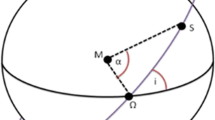Abstract
ISRO is launching a LiDAR instrument (LLRI) onboard Chandrayan-I. The LLRI will collect topographic data of lunar surface. Flying at an altitude of 100km the LLRI will have a footprint of 100m on the moon surface. Time of travel measurement, which is fundamental for topographic coordinate computation, depends upon the shape of the return pulse. This shape in turn is a function of the characteristics of footprint, i. e. its geometry, reflectance and roughness. This paper uses a mathematical model to simulate the return waveform at the receiver for different conditions of said characteristics within the footprint. Mathematical equations are employed to generate footprints that vary in their characteristics in terms of reflectance, geometry and roughness. A footprint is divided into small bins so that each bin has uniform property. Energy distribution in transmitted pulse is considered Gaussian. Energy irradiated over footprint is approximated using the assumed distribution. For each bin the energy incident is computed and accordingly the quantum and distribution of reflected energy is determined. The final waveform is generated by integrating the energy returned from all the bins according to their time of arrival and spread. Some results are presented to show the performance of the developed system.
Similar content being viewed by others
References
Filin S and Csathó B (2000) An efficient algorithm for the synthesis of laser altimeter waveforms. BPRC technical report: 1–28
Gardner CS (1992) Ranging performance of satellite laser altimeters. IEEE transaction on Geoscience and remote sensing 30(5):1061–1072
Harding DJ, Lesky M A, Parker GG and Blair JB (2001) Laser altimeter canopy height profiles: Methods and validation for closed-canopy, broadleaf forests. Remote Sens Environ 76(2001):283–297
Hofton MA and Blair JB (2001) Laser pulse correlation: A method for detecting subtle topographic change using LiDAR return waveforms. Int Archi Photogrammetry Remote Sens XXXIV-3/W4:181–184
Jutzi B and Stilla U (2006) Precise range estimation on known surfaces by analysis of full waveform laser. Symposium of ISPRS commission III: Photogrammetric Computer Vision (PCV06) 36(3):234–239
Sun G and Ranson J (2000) Modeling LiDAR returns from forest canopies. IEEE Tran. on Geoscience and remote sensing 38(6):2617–2626
Wagner W, Ullrich A, Ducic V, Melzer T, Studnicka N (2005) Gaussian decomposition and calibration of novel small-footprint full waveform digitizing airborne laser scanner. ISPRS J Photogrammetry Remote Sens 60(2006):100–112
Author information
Authors and Affiliations
Corresponding author
About this article
Cite this article
Lohani, B., Bhatnagar, N. & Roshan, A. Return pulse waveform simulation for LLRI instrument onboard Chandrayan-I. J Indian Soc Remote Sens 36, 1–11 (2008). https://doi.org/10.1007/s12524-008-0001-7
Received:
Accepted:
Published:
Issue Date:
DOI: https://doi.org/10.1007/s12524-008-0001-7




